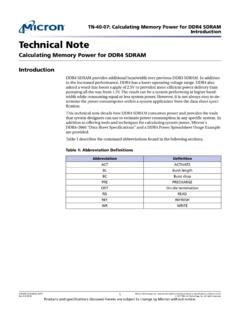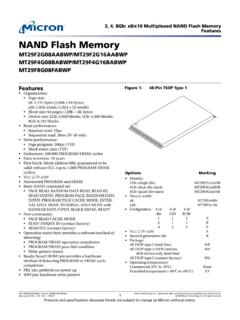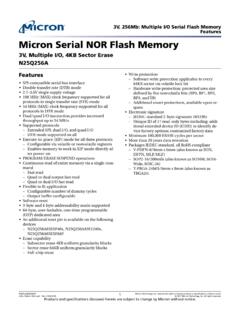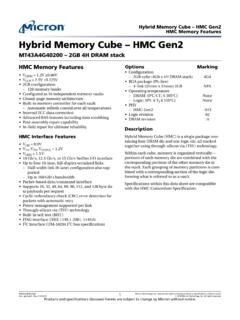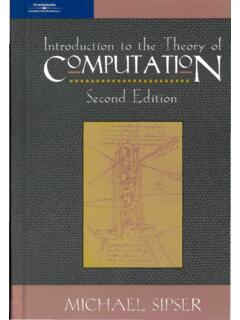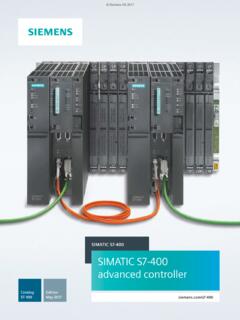Transcription of TN-41-13: DDR3 Point-to-Point Design Support
1 TN-41-13: DDR3 Point-to-Point Design Support introduction technical Note DDR3 Point-to-Point Design Support introduction Point-to-Point Design layouts have unique memory requirements, and selecting the right memory Design methodology can be critical to a project's success. While DDR3. SDRAM was targeted for use on modules, it can easily be adapted for Point-to-Point ap- plications. DDR3 is an evolutionary transition from DDR2. DDR3 Point-to-Point systems are simi- lar to DDR2 Point-to-Point systems; both require similar Design principles. But given that DDR3 signaling is more critical, DDR3 Point-to-Point systems require an emphasis on improving the data bus signaling. Before reviewing this technical note, a basic understanding of DDR2 Point-to-Point de- sign methodologies and DDR3 operation is recommended.
2 Micron's DDR3 data sheet, along with the following technical notes, are available for reference on : TN-00-20: Understanding the Value of Signal Integrity Testing TN-41-02: DDR3 ZQ Calibration TN-41-04: Dynamic On-Die Termination TN-46-02: Decoupling Capacitor Calculation for a DDR Memory Channel TN-46-06: Termination for Point-to-Point Systems TN-46-11: DDR SDRAM Point-to-Point Simulation Process TN-46-14: Hardware Tips for Point-to-Point System Design : Termination, Layout, and Routing TN-47-19: DDR2 ( Point-to-Point ) Features and Functionality TN-47-20: DDR2 (Point-to-Pont) Package Sizes and Layout Basics PDF: 09005aef84b67966. - Rev. B 08/13 EN 1 Micron Technology, Inc. reserves the right to change products or specifications without notice.
3 2013 Micron Technology, Inc. All rights reserved. Products and specifications discussed herein are subject to change by Micron without notice. TN-41-13: DDR3 Point-to-Point Design Support DDR2 to DDR3 SDRAM Comparison DDR2 to DDR3 SDRAM Comparison When designing Point-to-Point memory systems, the major differences between DDR2. and DDR3 include: An increase in bandwidth from 800 MT/s to 1600 MT/s, with optional 1866 MT/s and 2133 MT/s. An increase in the minimum clock frequency from 125 MHz to 300 MHz. Narrower DDR3 output drive ranges that can be recalibrated to adjust for voltage and temperature variations. Adjustable on-die termination (ODT) with dynamic control that provides ODT sup- port during writes without having to wire the ODT signal.
4 Small FBGA package sizes that enable high-density devices in extremely compact footprints for improved power delivery. See Table 1 (page 3) for a more detailed comparison. PDF: 09005aef84b67966. - Rev. B 08/13 EN 2 Micron Technology, Inc. reserves the right to change products or specifications without notice. 2013 Micron Technology, Inc. All rights reserved. TN-41-13: DDR3 Point-to-Point Design Support DDR2 to DDR3 SDRAM Comparison Table 1: DDR3 Point-to-Point Advantages Feature/Option DDR2 DDR3 DDR3 Advantage Voltage (core, I/O) Lower power Low power (core, I/O) NA Lower power VREF input 1 all inputs 2 DQs and CMD/ADDR Improved power delivery Data rate 800 MT/s 1600 MT/s 2X data rate tCK DLL enabled 125 400 MHz 300 800 MHz 2X clock rate tCK DLL disabled Undefined 125 MHz Slow clock debug Prefetch 4 bits (4n) 8 bits (8n).
5 Burst length (selectable) BL4, BL8 BC4, BL8 . Burst type Fixed Fixed, on-the-fly (OTF) . Additive latency (selectable) 0, 1, 2, 3, 4 1, CL - 1, CL - 2 . Data bus ODT nominal Yes Yes . ODT nominal standby 50 , 75 , 150 20 , 30 , 40 , 60 , 120 . ODT nominal writes 50 , 75 , 150 40 , 60 , 120 Improved signaling Data bus ODT dynamic No Yes ODT without ODT pin control ODT dynamic writes NA 60 , 120 Improved signaling Data Bus ODT variation 20% 10% . Driver impedance (full) 18 ( ) 34 ( ) Improved signaling Driver variation (full) 37 59% 10% Improved signaling Driver impedance (reduced) 40 ( ) 40 (36 44 ) Improved signaling Driver variation (reduced) 44 111% 10% Improved signaling Driver/ODT calibration None Via external R Improved signaling Multipurpose register (MPR) None Outputs.
6 Predefined pattern Write leveling None DQS captures clock De-skews if fly-by used Reset None Dedicated input . Automatic self refresh (ASR) None Optional Self refresh if TC > 85 C. FBGA package 60/84-ball 78/96-ball Improved power busing PDF: 09005aef84b67966. - Rev. B 08/13 EN 3 Micron Technology, Inc. reserves the right to change products or specifications without notice. 2013 Micron Technology, Inc. All rights reserved. TN-41-13: DDR3 Point-to-Point Design Support DDR2 to DDR3 SDRAM Comparison DDR3 Overview DDR3 functions much like DDR2 in that a source-synchronous data strobe is used, and data is transferred on both the leading and trailing strobe edges. However, DDR3 has an 8n-prefetch architecture where the internal data cycle time is one-eighth the external data rate, and the internal data bus width is eight times the size of the external data bus width.
7 For example, a x16 DDR3 SDRAM device has a 128-bit-wide internal data bus, so for each single access to or from the internal array, eight data transfers of 16 bits each will be provided externally. Because of the 8n prefetch, burst lengths are limited (BL = 8). In addition to 8n prefetch, both the DDR3 core and the I/O operate from a power source (DDR3L is ). With the advanced process technology, lower operating volt- age, and input voltage swings, DDR3 and DDR3L provide significant reduction in over- all power consumption. DDR3L ( ) will work well in Point-to-Point designs alongside DDR3 ( ). While DDR3L has the same timings as DDR3, DDR3L does not have as much voltage margin. However, the reduced voltage margin is not typically an issue with a well-terminated Point-to-Point system.
8 Memory Architecture SDRAM, DDR, and DDR2 memory system architectures assume a symmetrical tree lay- out coupled with minimal clock skews between command/address/control buses and the data bus. DDR3 memory system architectures assume a daisy-chain, or fly-by, lay- out. When developing systems that Support JEDEC DDR3 modules, fly-by architecture must be supported. DDR3 Point-to-Point designs, on the other hand, do not have to be implemented using a fly-by architecture. A DDR3 Point-to-Point Design can employ either the DDR2 tree ar- chitecture (minimal timing skew concerns; command/address/control buses that likely do not require termination) or the DDR3 fly-by architecture (significant timing skew be- tween clock and data buses; command/address/control buses that require termina- tion).
9 Write leveling was added to DDR3 to remove the skew (induced by the fly-by architec- ture) between the command/address/control/clocks buses and each of the DRAM data buses, as shown in Figure 1 (page 5). Even if fly-by architecture is used in a point-to- point system, it is generally better to hard code the skews rather than use the write-lev- eling feature. PDF: 09005aef84b67966. - Rev. B 08/13 EN 4 Micron Technology, Inc. reserves the right to change products or specifications without notice. 2013 Micron Technology, Inc. All rights reserved. TN-41-13: DDR3 Point-to-Point Design Support DDR2 to DDR3 SDRAM Comparison Figure 1: DDR2 Tree vs. DDR3 Fly-By Architecture Command/Address/ DDR2 DDR3.
10 Control/Clocks Command/Address/. Control/Clocks DQS DQS. Data valid DQS. DQS. DQS. DQS. DQS. DQS. DQS. On-Die Termination (ODT). Like DDR2 ODT, DDR3 ODT reduces layout constraints by eliminating the need for dis- crete termination to V TT and the need for V TT generation for the data bus. ODT im- provement is one of the more significant additions to DDR3. ODT has been improved in the following ways: Value reduction Closer impedance matching for Point-to-Point systems, providing improved signal quality Calibration control Neutralizing voltage and temperature shifts, providing improved signal quality Tighter ranges Less variation, providing tighter control and improved signal quality Dynamic ODT Desired termination opportunistically applied during writes A summary of the DDR3 ODT resistors is shown in the ODT Settings for MR1 and MR2.

